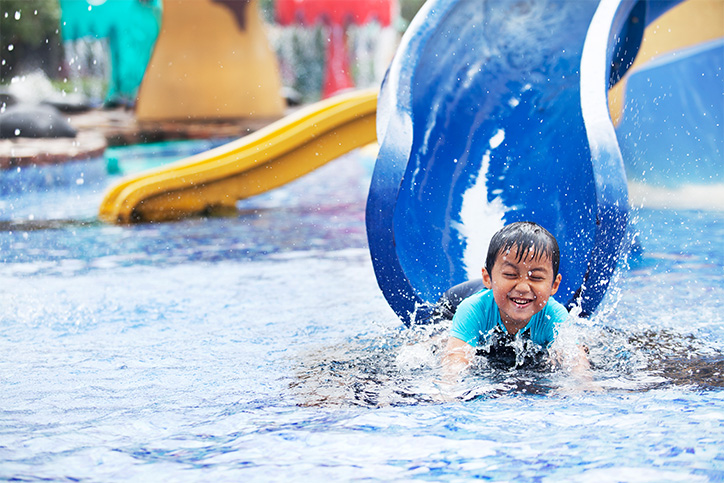Families looking for quality recreation time in a safe environment often choose an indoor waterpark for their family entertainment. Indoor waterparks offer a safer option than oceans, lakes, and rivers, and even some swimming pools.
Waterparks can be indoors, outdoors, or both, and often feature blended amusement park concepts that create a fun, family-oriented environment. A family may invest hundreds or even thousands of dollars in a waterpark vacation. Indoor waterparks are the fastest-growing segment of the waterpark industry.
Waterparks — whether indoor or outdoor — pose a unique set of risks that waterpark owners and operators need to be aware of and take steps to mitigate.
Waterslides pose the highest risk of injury at a waterpark, while wave pools have the highest risk of drowning, and young, inexperienced swimmers are at particularly high risk. Lifeguards may have difficulty seeing a drowning victim or near-drowning victim in a wave pool because of the simulated ocean-like environment.
Owners and operators of waterparks must remain vigilant, even during the off-season, to reduce the risk of injuries and the lawsuits that can follow them. They must take steps to ensure that their facility is properly maintained, that the waterpark is adequately staffed, and that staff members are following applicable regulations and guidelines.
If an injury does occur at a waterpark, owners, operators, and employees could be sued and held liable.
Know the laws that apply to indoor waterparks
In the United States, amusement rides, including waterparks, are regulated through a patchwork of federal, state, and local laws, and by voluntary adherence to industry standards.
The U.S. Consumer Protection Safety Commission (USCPSC) is authorized to investigate accidents that occur at amusement parks and may work with ride manufacturers to correct product defects or hazards to specific machinery. However, the USCPSC is only authorized to regulate mobile rides and attractions. This means that most rides operated at amusement parks and waterparks are exempt from federal safety oversight.
State and local governments may establish safety and audit programs for amusement park and waterpark rides that operate within their jurisdictions. Because federal safety officials are not permitted to address safety concerns on fixed park rides, each state and local government bears the full burden of overseeing safety on all waterpark and amusement park rides. This includes collecting data, analyzing trends, investigating serious accidents, and negotiating with manufacturers to mitigate product defects.
Waterparks must also adhere to manufacturer requirements.
Maintain rides, floors, and ventilation and water systems
When the busy season is over, it is easy to become complacent. But a park that is poorly maintained and managed may experience a reduction in safety, staff, and equipment checks that can lead to costly injuries and liability exposure.
Make sure to have proper staffing in place and remain diligent about enforcing standards, even during the off-season. The off-season is also a great time to perform testing for any new rides that may be introduced for the next busy season.
Remain vigilant about cleaning and checking floors for hazards to prevent slips, trips, and falls. Monitor and maintain ventilation and water systems and continue to encourage staff to report issues to prevent conditions from worsening.
Record keeping and liability waivers
Detailed records should be kept all year long, not just during the peak season.
All guests should sign liability waivers. While they are not enforceable in all states, liability waivers are a useful tool for warning guests of potential risks. Liability waivers should be worded as clearly as possible.
Any injury that does occur should be documented with an incident report of what happened. The report should also include eyewitness information. This information will be necessary if a claim is made and should also be used to identify issues with rides or safety protocols.
Make sure a manager or supervisor is completing the report, not an entry-level staff member.
Detailed record-keeping can help identify trends, which can be used to reduce the risk of injury further.
If a guest claims they were injured because a ride malfunctioned, check the attraction immediately, even if that means a temporary shutdown in operations.
Consider installing surveillance cameras and a DVR system. The off-season is an excellent time to implement these systems, so they are in place for the upcoming busy season. Surveillance cameras can be used to document irresponsible guest behavior and rule violations, to positively address safety concerns and monitor the facility. They can aid in loss prevention and reduce theft.
Maintain safe operation of waterslides at indoor water parks
A staff member should be placed at the entrance to any waterslide to advise guests on the proper way to ride and to signal when guests are cleared to go.
All waterslides should have clear, step-by-step instructions posted on how to ride, as well as height and age restrictions. Most waterslides have a pool located at the end of the track. A lifeguard should be stationed there to help guests who need assistance. Personal floatation devices should always be available, and waterslides should be well-lit during evening and night-time operations.
Keep your commitment to safety and fun
McGowan Program Administrators’ FEC Insurance Program offers years of FEC industry and insurance program experience. We’ve designed a program delivering coverage and loss-control services that go above and beyond rivals. We know waterparks, and we can help your owners and operators keep their commitments of safety and fun for their customers.
Learn more about the McGowan Family Entertainment Center Insurance Program, and contact us today to learn how we can help with insurance and risk management. We will guide you to the knowledge you need to succeed.


